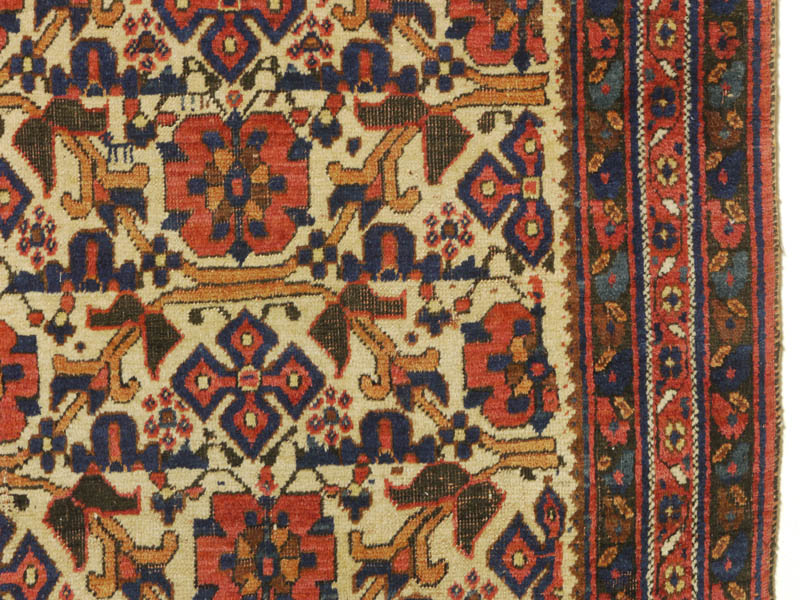Click on image to view in larger size.
See image in extra large size (opens jpg in same window)(1 MB).

The squarish format and the weave (ribbed back, ivory warps, orange wefts) indicate an Afshar attribution. Whether the rug is ethnically Afshar or woven by Persian villagers in the vicinity of Kerman is impossible to ascertain. Eiland & Eiland state that "little is knwn about the rural rugs of Kerman (...) As to who wove which rugs, there is currently no way of knowing." (Oriental rugs - a complete guide). Due to the depressed weave, it is not even easy to establish whether the rug is symmetrically knotted or uses the Persian knot, which would be no more than a hint in either direction. Eiland & Eiland state that "at times alternate warps are morderately depressed". In this rug, warp depression is pronounced.
A rug with the same pattern, but rendered on red ground, is currently in the inventory of Haliden, Bath, UK. They call it 'Neriz Afshar'. I am not sure how well grounded this attribution is, but I have nothing better to offer.
A repeat design: a horizontally meandering vine from which lilly-like flowers sprout forms a kind of hexagonal lattice that encloses a group of motifs: a large rosette and above it, a kind of quatrefoil element, whcih may also be a geometricised blossom, plus some small blossoms and floral elements. There is an echo of the mina khani pattern but I think this design differs in too many respects to be called a mina khani variant. To both side o the coupled quatrefoil and rosette motifs, there are horizontally stretched motifs which I cannot work out; they seem simply cut off at the base. Interestingly, some small animals are strewn in between, a feature missing in the Haliden companion piece.
The rug measures 6ft.1in. x 4ft.7in. (185 x 141 cm). Ivory wool warps with strong twist, double wefts (orange wool), strong depression (ca. 70°). 30/10 cm vertical,35/10 cm horizontal = 1050 knots per dm2. Translated into kpsi, this is about 8.v, 9.h = 72 kpsi. The pile is quite good in many areas ca. 3-4 mm, lower in the central areas. The handle is flexible despite the depressed structure, and quite heavy and meaty.
A very limited but effective palette of clearly all organic dyes: yellowish ivory white (the ground), a beautifully abrashed brick red shade of madder (in the rosettes) a burnt orange (the vine lattice), medium and dark indogo blue, and a dark brown (partly corroded).
Quite good pile, brown somewhat corroded, which in the borders makes the other colours stand out as if embossed. Walter Brew of Thunderstrand has carried out some work on the rug: Some very minor repiling of old moth bites; some areas of the right selvedge have been reconstructed, and both selvedges have been newly rewrapped; the ends have been secured. The rug has been carefully hand-washed and is now clean.














